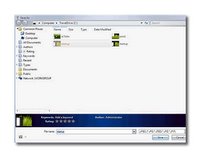
Microsoft has more work to do on its new operating system, but this first beta suggests that Windows Vista will be on a par with Linux and Apple Mac OS X.
Microsoft has released Windows Vista Beta 1 (formerly known as Windows Longhorn) to a select group of testers. Microsoft's mantra (or advertising line) for Windows Vista is 'Confidence, clarity, and connection'. For you and me, that means a promise of greater stability and security within the OS, better graphics throughout, and an enhanced ability to share documents and files, including built-in P2P services.
The Beta 1 build is a programmers' build -- that is, Microsoft wants to make sure that developers know how the new OS works before they put the finishing touches on the overall look and feel of Windows Vista. A second beta is expected by the end of 2005. Final shipping of the new Windows operating system won't occur until the second half of 2006.

In Windows Vista, Microsoft borrows a lot of clever ideas from its competitors.
Borrowing from Linux, Windows Vista runs all users at a Standard user level and creates a separate Administrator login, so even if you are the only user of the OS, you will still need to log in with Administrator privileges to do high-level work, such as changing the status of hidden or read-only files. Standard users should still be able to install and uninstall applications, provided they know the password for Administrator privileges. This extra effort should minimise the occurrence of spyware installing without your knowledge and remote-access exploits from taking control of your computer.
Borrowing from Apple Mac OS X 10.4 Tiger, Windows Vista incorporates enhanced desktop search features throughout its new OS. You can search from the Windows Start menu or within applications, and you can also search within the new version of Internet Explorer 7.0. Also borrowing from Apple, Windows Vista does away with traditional file folders and allows you to 'stack' related documents together. These virtual files can exist independent of where the actual file resides on the hard drive.
When you open or save a file, you can also change its metadata on the fly. Note the file path at the top -- no more slashes.
We especially like the fact that you can both see and alter a file's metadata whenever you open or save a document. The metadata is important because Windows Vista uses metadata to index files. Better yet, say you want to drag and drop a file from one stack (pictures of France) to another (pictures of me); the metadata is automatically changed once the file is relocated.
Addressing its own past mistakes, Microsoft has changed the way some drivers operate within the new OS. For example, a leading cause of the dreaded Blue Screen of Death (system crash) is printer drivers, which have historically been installed at the kernel level of the OS. With Windows Vista, printers will be installed only at the user level -- thus, if a printer driver has a problem, you will be informed, but the system won't crash as a result.
Microsoft also swears that it is scanning every line of code within Windows Vista, aiming to reduce the number of patches by 50 percent within the first 90 days of release, compared to the XP release.
Unfortunately, the new ability for the Windows Vista firewall to stop malicious activity both inbound and outbound will not be enabled by default. We don't understand this decision, although Microsoft insists that it's better not to enable two-way firewall protection right out of the box. So, to protect yourself from aggressive spyware, we recommend you either go into the Control Panel and activate the two-way firewall option yourself or disable the Windows Vista firewall entirely and install a third-party firewall. Another option is to enroll in the new OneCare service from Microsoft (also in beta at this writing); subscribers to OneCare will automatically have two-way firewall protection enabled.
We'd like to see several interface changes, as well. For example, right now, if you have more than two applications open on the desktop, the status bar shows only one, with up and down arrows. Instead of chaining icons for the various open programs across the bottom of the desktop, you'll have to scroll. In informal testing, we found ourselves opening several instances of Internet Explorer and Notepad because it was easy to forget they were already open.
It's too early to say how successful Microsoft Windows Vista will be. Windows XP hasn't swept the world after four years (there are millions of people still using Windows 98 SE, for example), and in the corporate space, Windows 2000 remains the preferred environment, despite Microsoft's many attempts to discontinue support of Windows 2000. Check back at the end of 2005 to read about how the second beta performs.

0 comments: